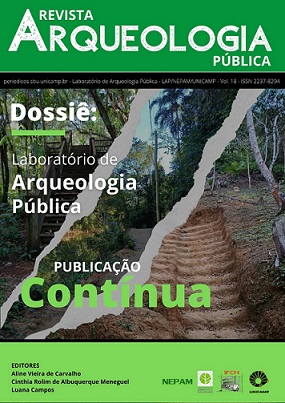Abstract
This article versa about the archaeological cultural heritage inserted in the polygon formed by the Municipality of Nova Iguaçu and their emancipated districts, located in Baixada Fluminense, Metropolitan Region of Rio de Janeiro. Have as objectives to present public archeology as a theoretical-methodological current with mitigating potential to the risks to which such heritage is subjected as a result of the impacts caused by the intense urbanization process, ongoing, in the reference region of this study.It is expected to offer theoretical support that contributes to the inclusion of this heritage in the political and social agendas and to the planning of actions that will ensure the conservation of this collection, seen here, as a cultural resource to be explored by a social capital in emergency.
References
BASTOS, Rossano Lopes. O registro arqueológico como instrumento de memória social: novas abordagens. In: OLIVEIRA, Ana Paula de Loures; OLIVEIRA, Luciane Monteiro (Orgs.). Arqueologia e Patrimônio de Minas Gerais: Ouro Preto. Juiz de Fora: Ed. UFJF, 2010. p.7-22. Disponível em HYPERLINK "file:///C:UsersarqueDownloadsO_Registro_arqueologico_como_instrumento.pdf" O_Registro_arqueologico_como_instrumento.pdf Acesso em 03 ago. 2022.
BASTOS, Rossano Lopes; SOUZA, Marise C. (Orgs.). Normas e gerenciamento arqueológico. 2ª ed., 9º SR/IPHAN, São Paulo, SP, 2008.
BASTOS, Rossano Lopes. Arqueologia Pública e Gestão do Patrimônio Cultural Arqueológico Brasileiro. Conferência de abertura da Disciplina Gestão do Patrimônio Cultural Brasileiro no Programa Erasmus Mundus: mestrado de Arqueologia e arte rupestre. IPT/UTAD. [S/D]. Disponível em HYPERLINK "https://usp-br.academia.edu/RossanoLopesBastos" (99) Rossano Lopes Bastos | Universidade de São Paulo - Academia.edu Acesso em 13 mar. 2022.
BRASIL, IPHAN. Educação Patrimonial: Histórico, Conceito e Processo. 2014. 2. ed. revista ampliada. Iphan/DAF/Cogedip/Ceduc, Brasília, DF 2014. Disponível em HYPERLINK "http://portal.iphan.gov.br/uploads/ckfinder/arquivos/EducPatrimonialweb_final_segunda%20edicao.pdf" EducPatrimonialweb_final_segunda edicao.pdf (iphan.gov.br) Acesso em 13 mar. 2017.
CANCLINI. Néstor García. O Patrimônio Cultural e a Construção Imaginária do Nacional. Revista do Patrimônio Histórico e Artístico Nacional, nº 23, p.p. 91-111. Tradução de Mauricio Santana Dias, 1994.
CASTELLS, Manuel. A Questão Urbana. 4ª edição. Coleção Pensamento Crítico. Vol. 48. Ed. Paz e Terra. São Paulo. SP. 2009.
DIAS, Ondemar; NETO, Jandira. A Pré-História e a História da Baixada Fluminense: A ocupação humana na Bacia do Rio Guandu. Instituto de Arqueologia Brasileira, IAB Editora, Belford Roxo-RJ, 2017.
DIAS, Ondemar, CARVALHO, Eliana, RODRIGUES, Calasans. Sítio Madame Picucha. Coleção Museu 95. IAB. Fazenda Calundu. Belford Roxo. RJ. S.D.
FONSECA, M. C. L. Da modernização à participação: a política federal de preservação nos anos 70 e 80. Revista do Patrimônio Histórico e Artístico Nacional, Brasília, n. 24, p. 153-163, 1996.
FUNARI, Pedro Paulo Abreu; OLIVEIRA, Nanci Vieira; TAMANINI, Elizabete. Arqueologia Pública no Brasil e as novas fronteiras. Praxis Arqueológica, nº 3, p. 131-138, 2008. ISSN 1646-1983
FUNARI, Pedro Paulo; CAMARGO, Vera Regina Toledo (Org). Divulgando o patrimônio arqueológico. Editora Bonecker. 1ª Edição. Rio de Janeiro, RJ, junho de 2018.
FUNARI, Pedro Paulo A.; ROBRAHN-GONZÁLEZ, Erika M. Ética, Capitalismo e Arqueologia Pública no Brasil. Dossiê: Patrimônio Histórico. HISTÓRIA, São Paulo, 27 (2): 2008.
GOULD, Peter G. On the Case: Method in Public and Community Archaeology. University of Pennsylvania Museum of Archaeology and Anthropology, USA Public Archaeology pp. 1-18. Ed. Routledge Taylor & Francis Group. UK. 2016.
JAMESON JR, John H. Public Archaeology in the United States. In Public Archaeology, MERRIMAN, Nick (Edited by). Routledge, Taylor & Francis Group. p. 21-58. London, UK, 2004.
MATSUDA, Akira. The concept of “the Public” and the aims of Public Archaeology. Papers from the Institute of Archaeology 15, p. 66-76. UK. 2004.
MICELI, Sérgio. SPHAN: refrigério da Cultura Nacional. In RIPHAN, nº 22 pp. 44-47, Brasília, DF, 1987.
MOSHENSKA, Gabriel. Key Concepts in Public Archaeology. University College London. Institute of Archaeology. February 2017. https://www.ucl.ac.uk/ucl-press/browse-books/key-concepts-in-public-archaeology
MOSHENSKA, Gabriel. What is Public Archaeology? University College London. Institute of Archaeology. Present Pasts, vol. 1 nº1, (2010). DOI: http://doi.org/10.5334/pp.7
REVELL, Louise. Constructing Romanitas: Roman public architecture and the archaeology of practice. In Baker, P., Forcey, C., Jundi, S., and Witcher, R. (eds.) (1999) TRAC 98:Proceedings of the Eighth Annual Theoretical Roman Archaeology Conference. Oxford: Oxbow Books. April 2013.
RIO DE JANEIRO. INEA. E—07-202.161-2006 Nova Iguaçu Gasoduto Japeri Petrobras. Disponível em http://www.inea.rj.gov.br/eia-rima-2007 , Acesso em 23 abr. 2022.
RUBINO, Silvana. O Mapa do Brasil Passado. In Revista do Patrimônio Histório e Artístico Nacional. IPHAN, p.p. 97-105. Ano 1996.
SÁNCHEZ, Jaime Almansa. Arqueología para todos los públicos. Hacia una definición de la Arqueología Pública «A La Española. ArqueoWeb, 13, p-p. 87-107. 2011. ISSN: 1139-9201 Disponível em https://www.academia.edu Acesso em 16 mar. 2016.
SANTOS, Mariza veloso Motta. Nasce a Academia SPHAN. Revista do Patrimônio Histórico e Artístico Nacional, nº 24, p.p.77-95, 1996.
SCHADLA-HALL, Tim. Editorial: Public Archaeology. European Journal of Archaeology, 2:2, 147-158, University College London, UK, jul 2013.
UNESCO. DECLARAÇÃO DE CARACAS. In Cadernos de Sociomuseologia, nº 15. ICOM, Caracas, Venezuela, 16-01 a 06-02-1992.
VIEIRA, Silviane de Souza; TEIXEIRA, Simonne. Campos dos Goytacazes e o IPHAN nos anos de 1930: Identidade Nacional e Preservação do Patrimônio. Cadernos de Pesquisa do CDHIS – Número Especial – v. 33, ano 18, Uberlândia, MG, 2005.
WHEELER, Mortimer. Arqueología de Campo. Fondo de Cultura Económica. Tercera reimpresión (FCE-Espanha), Madri, Espanha,1995.
WIJESURIYA, Gamini. Conserving the Temple of the Tooth Relic, Sri Lanka. In Public Archaeology. Org. ASCHERSON, Neal & MCMANAMON, Francis. v. 1, n. 2, p. 99-108, ed. James & James (Science Publishers) Ltd, 2000.

This work is licensed under a Creative Commons Attribution-NonCommercial 4.0 International License.
Copyright (c) 2023 Revista Arqueologia Pública


